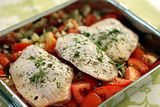
 Here are the results of some much needed tartlet pastry practice. I usually use the tartlet pans with removable bases, but then they don't come in cute, tiny sizes or in a great variety of shapes. Now that I have discovered Dorie Greenspan's superb Pate Sucre recipe, I am determined to perfect the art of making mini tarts.
Here are the results of some much needed tartlet pastry practice. I usually use the tartlet pans with removable bases, but then they don't come in cute, tiny sizes or in a great variety of shapes. Now that I have discovered Dorie Greenspan's superb Pate Sucre recipe, I am determined to perfect the art of making mini tarts.My first effort bombed as I couldn't get the pastry out of any of the cases - it all ended up in the sink. So on to Baking 911 and the Ask Sarah Forum. I learned the main technique for an easy tartlet release is to refrigerate (or freeze) them after they have baked and cooled. Then after about an hour or more, dip the bottom of each tartlet pan in freshly boiled water, just for a few seconds. Turn upside down on the sink top and they should release immediately - if they don't, just tap them a bit and the job is done.
I've built on the process a bit - when I make the shells now it's a bit like doing complicated long-division sums with a pencil and paper but I think it's worth it -
Shery Trifle's Tartlet Case Process
1. Make Dorie's Pate Sucre and refrigerate as instructed in the recipe (recipe follows).*
2. Spray the tartlet tins with lots of Mazola Oil spray.
3. Cut off as much as needed of the pate sucre and put the rest back in the fridge.
4. Take pieces of pastry and press into the tins, using thumb and fingers. Make sure that the whole surface of each tin, including all the flutes, is completely covered with 1/8 inch of pastry. Remove any pastry that sticks up from the top edge of the tin.
5. Refrigerate again for at least 30 mins. This stops the pastry bases from puffing up in the oven and it allows for a nice even baking.
6. Place tartlet pans in a 350 degree oven on a baking try (I use a pizza pan - it's nice and light to manouvre) and bake pastry for about 11 minutes. The edges should be just a teeny bit brown in parts and the rest a creamy yellow.
7. Remove tartlets from oven and slide from tray onto the counter top. Let cool completely.
8. Place in refrigerator (or freezer)for at least an hour.
9. Fill shallow pan with boiling water. Remove pastry tins from refrigerator and
quickly dip base of each tartlet pan in the hot water, for just a few seconds.
10.Turn upside down on counter top - the pastry should release. If it doesn't, just give it a tap (or two) and the shells will come out looking rather pretty and adorable, ready for yummy fillings.
*Dorie Greenspan's Pate Sucre Recipe
SWEET TART DOUGH
1 1/2 cups all-purpose flour
1/2 cup confectioners' sugar
1/4 teaspoon salt
1 stick plus 1 tablespoon (4 1/2 ounces) very cold (or frozen) unsalted butter, cut into small pieces
1 large egg yolk
To make the dough: Put the flour, confectioners’ sugar and salt in the workbowl of a food processor and pulse a couple of times to combine. Scatter the pieces of butter over the dry ingredients and pulse until the butter is cut in coarsely – you’ll have pieces the size of oatmeal flakes and pea-size pieces and that’s just fine. Stir the egg, just to break it up, and add it a little at a time, pulsing after each addition. When the egg is in, process in long pulses – about 10 seconds each – until the dough, which will look granular soon after the egg is added, forms clumps and curds. Just before your reaches this clumpy stage, the sound of the machine working the dough will change – heads up. Turn the dough out onto a work surface.
Very lightly and sparingly – make that very, very lightly and sparingly – knead the dough just to incorporate any dry ingredients that might have escaped mixing.
If you want to press the dough into a tart pan, now is the time to do it.
If you want to chill the dough and roll it out later (doable, but fussier than pressing), gather the dough into a ball (you might have to use a little more pressure than you used to mix in dry bits, because you do want the ball to be just this side of cohesive), flatten it into a disk, wrap it well and chill it for at least 2 hours or for up to 1 day.
To make a press-in crust: Butter the tart pan and press the dough evenly along the bottom and up the sides of the pan. Don’t be stingy – you want a crust with a little heft because you want to be able to both taste and feel it. Also, don’t be too heavy-handed – you want to press the crust in so that the pieces cling to one another and knit together when baked, but you don’t want to press so hard that the crust loses its crumbly shortbreadish texture. Freeze the crust for at least 30 minutes, preferably longer, before baking.
To make a rolled-out crust: This dough is very soft – a combination of a substantial amount of butter and the use of confectioners’ sugar – so I find it is easier to roll it between wax paper or plastic wrap or, easiest of all, in a roll-out-your-dough slipcover. If you use the slipcover, flour it lightly. Roll the dough out evenly, turning the dough over frequently and lifting the wax paper or plastic wrap often, so that it doesn’t roll into the dough and form creases. If you’ve got time, slide the rolled out dough into the fridge to rest and firm for about 20 minutes before fitting the dough into the buttered tart pan. Trim the excess dough even with the edge of the pan. Freeze the crust for at least 30 minutes, preferably longer, before baking.
To partially bake the crust: Center a rack in the oven and preheat the oven to 375 degrees F. Butter the shiny side of a piece of aluminum foil and fit the foil tightly against the crust. Bake the crust 25 minutes, then carefully remove the foil. If the crust has puffed, press it down gently with the back of a spoon. Bake for another 3 to 5 minutes, then transfer the crust to a cooling rack; keep it in its pan.
























